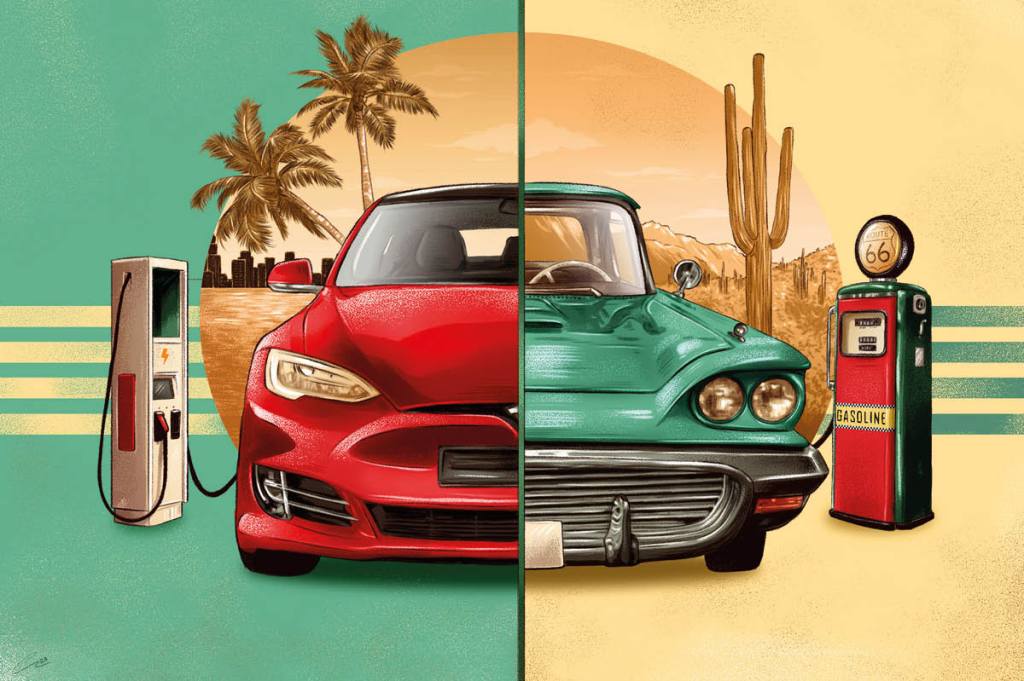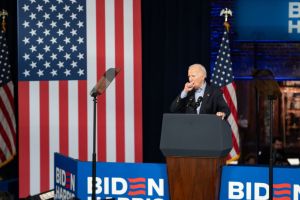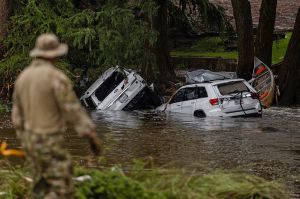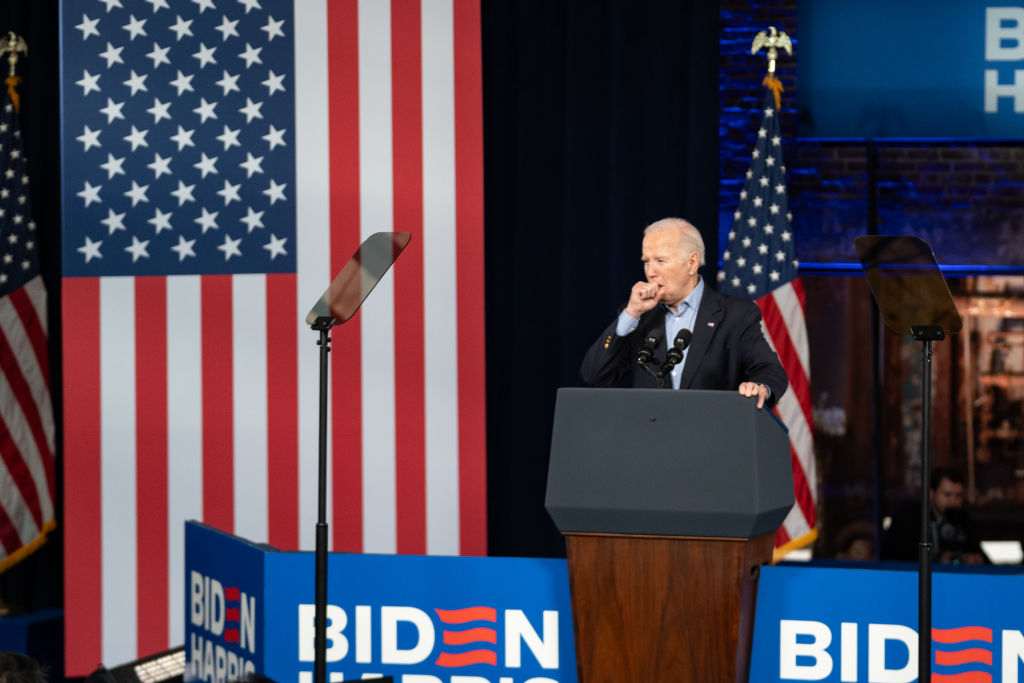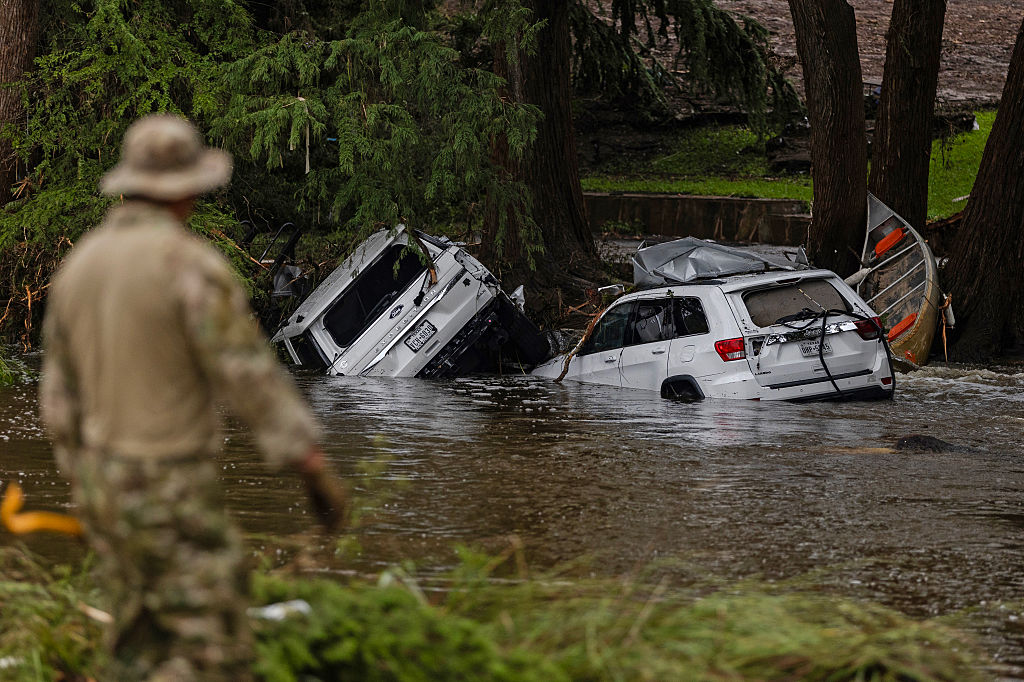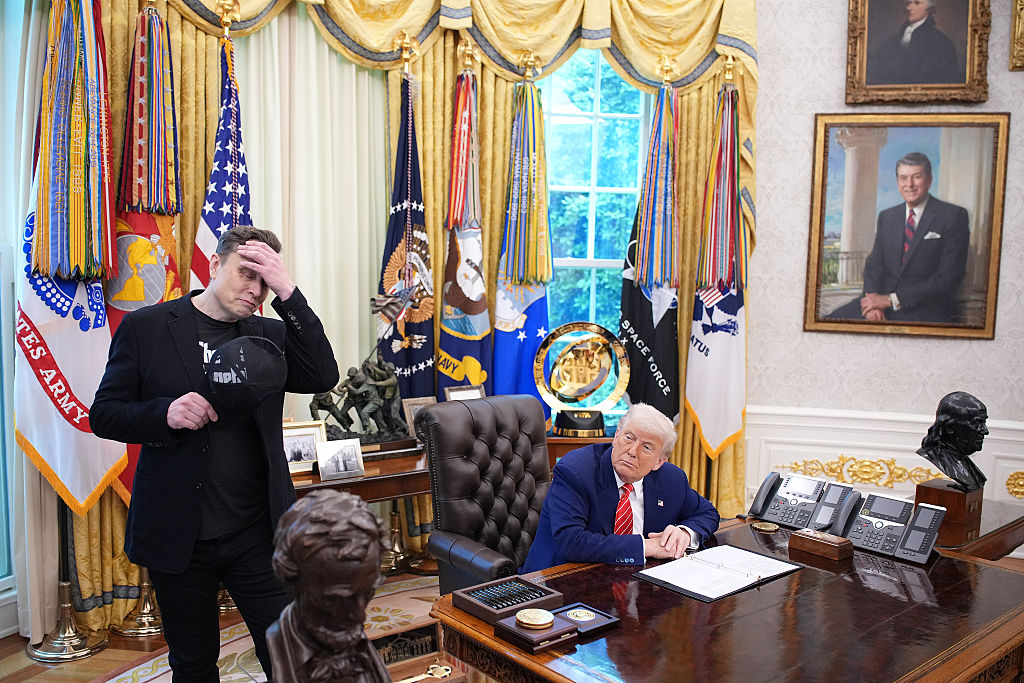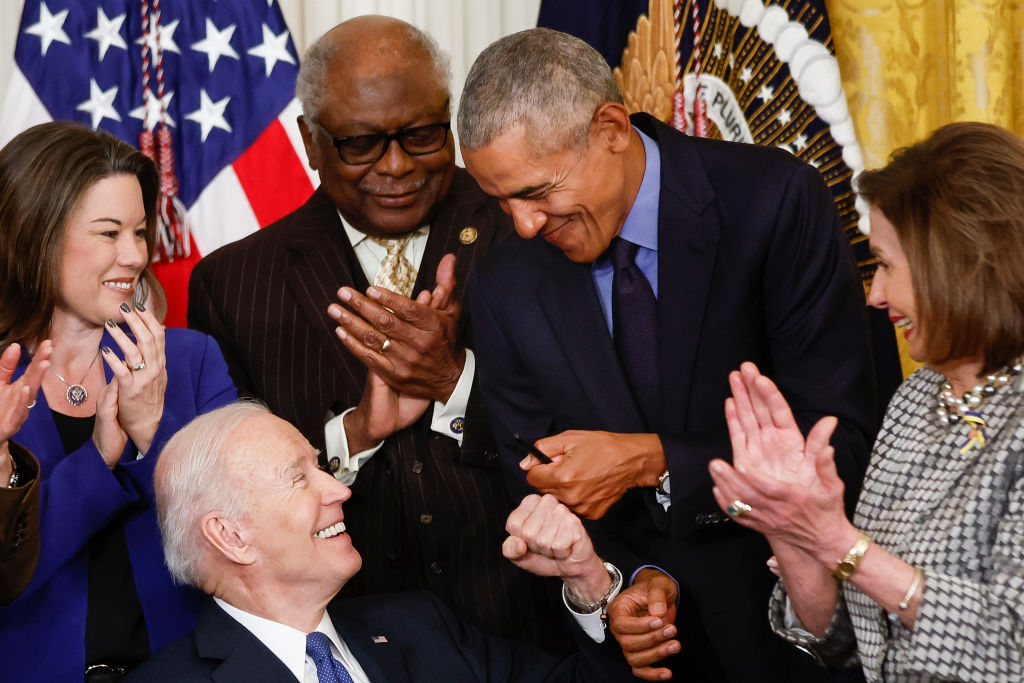It’s a cloudless spring day, made for a country drive. Chartreuse trees explode with pollen and glow to near neon. I wind past pastures and stone and brick farmhouses and amiable old barns that could set the scene of a Beatrix Potter story, elatedly adding to the hum of provincial enterprise by perfecting my rev-matching skills over the rolling hills and 8mph switchbacks that mark PA-74.
The quiet two-lane road spits me out into city limits, and suddenly I’m crawling through a crowd at the Carlisle Collector Car Auction.
I’m here to learn what classic car enthusiasts think of electric vehicles, or EVs. In 2021, President Biden issued an executive order establishing that, by 2030, half of new passenger cars sold must be all-electric or hybrid, going up to two-thirds by 2032. California plans to outlaw the sale of internal combustion engine (ICE) vehicles completely by 2035. Yet the data-analytics company J.D. Power reports that today, EVs “account for less than 1 percent of the 250 million vehicles, SUVs and light-duty trucks sold in the United States.” In 2022, EVs accounted for just 6 percent of new car sales, despite a $7,500 “clean vehicle” tax credit intended to incentivize consumers to buy electric and hybrid vehicles.
In the shade of a turquoise Ford Fairlane’s three-foot-long tailfin I ask Gary, from upstate New York, his views.
“We don’t have the electric structure to charge where I live,” he says. “If everybody charged their electric vehicle right now, we wouldn’t have heating or cooling in our houses.”
Gary has worked in construction for more than forty years and is concerned about battery waste and how we’ll mine all the lithium we’ll need for an electric future. “You need diesel machines to mine. I’ve run a lot of equipment, and you couldn’t go more than twenty minutes with an electric bulldozer.”
What’s more, Gary is a shade-tree mechanic. His idea of working on an EV? “Not fun. What’s fun about it? You’d need a schematic. I can buy an engine or transmission real cheap, and I can fix it myself.”
Gary finds comfort in his conviction that “Big Oil is not going to stop buying from those sheikhs in Saudi Arabia.”
I turn to a pair of Virginia men admiring a sensational 1970s-era Cadillac Coupe de Ville convertible the color of pea soup — with a matching interior. “I seen a lot of them electric cars catch fire,” one says with a shrug. “I guess they both got their problems.”
I size up the Cadillac’s all-business chrome grill, its sharp chrome bumper and chrome accents, stylized skirt and endless angles, and I think: at least if this thing caught fire, it would take ages to burn up.
Someone who calls himself “the Hillbilly Hoarder” tells me he hopes gas-powered cars become rare and collectible — for obvious reasons. Then Charles Brandon Boyd, a gregarious car dealer from North Carolina with an eagle eye for people wandering car lots in search of something, politely intervenes to share some industry secrets.
Boyd, wearing a Chevrolet polo shirt with the EV emphasized in contrasting thread, has just returned from all-day meetings in Las Vegas with Chrysler, Dodge, Jeep and RAM “to talk about the conversion we’re getting ready to see from ICE to EV, and before that, we met with General Motors about the same thing.
“The problem with General Motors,” says Boyd, “is that $26 billion has been spent, and they only have around 2,000 electric vehicles on the road today. The math isn’t working right now.”
Boyd says car manufacturers are experiencing “a lot of R&D struggles. This is new to everybody. The rollout is so fast. Is it premature? Absolutely it’s premature. Are we ready for this? There’s no way we’re ready for this. It’s an exciting time to be alive, and as a car dealer, I’m for this — the right way. Not a cram job. Not push, push, push, push.”
It seems American drivers are themselves duly skeptical of EVs. A University of Chicago Energy Policy Institute poll released in April found just “two in five would consider purchasing an electric vehicle as their next car,” with 80 percent of respondents citing a lack of charging stations as a main reason. The prohibitive cost of EVs, which are 20 percent more expensive, on average, than ICE vehicles, was another big discouraging factor.
Boyd asserts that customers are curious about EVs, but he doesn’t have any to sell. Chevy has ended production of the Volt. Ford’s electric truck, the F-150 Lightning, was on a stop sale for a month this year because of a potential battery problem.
A lot of EV fever, says Boyd, “is Washington and administrative-driven,” yet bureaucrats are trying to put the car before the horsepower.
“You can have all the EVs you want, but if you don’t have a place to get power and charge them, what’s the point in having them? We don’t have the infrastructure, the grid. Transformers in neighborhoods don’t have the capacity to charge them.”
“Range anxiety,” as it’s known, “is alive and well,” adds Boyd, “and that’s the number-one question and concern I hear about EVs.”
Andy Campbell knows more about range anxiety than possibly anybody in the US. As the head of PR and marketing for DiamondBack Covers, a truck-bed cover manufacturer Andy describes as “early adapters at heart, techy and forward-thinking,” he volunteered to test out the company’s electric truck (a 2022 F-150 Lightning Lariat) with a family road trip from Pennsylvania to California with his wife Rebecca and three-year-old son Oliver.
“It was going to be a twenty-six-day trip,” Andy tells me from the passenger seat of the Lightning. “Within an hour, we thought about turning around and me dropping [my family] off. I offered Rebecca a flight home multiple times.”
Crossing Pennsylvania’s Laurel Highlands, the Campbells watched the Lightning’s range deplete in real time. “The range would drop by three miles, and you only went a quarter-mile uphill,” Andy recalls. “If you have a high resting heart rate, this truck will drive you over the edge.” He offers as an analogy the feeling of seeing your iPhone’s battery turn yellow. “Imagine that, on your car, but in the middle of the desert.”
Within three hours of starting their trip, the Campbells found themselves in a hotel, because the only nearby charging station provided them just seventeen miles of range per hour of charge. Andy didn’t plan their route around charging stations on the way out, “because I didn’t think it would be that problematic. On the way home, that’s all I planned around.”
The journey west involved a lot of time spent at Walmarts using Electrify America charging stations that provide a power supply just for EVs from a gated-in transformer. These chargers are “pretty good,” says Andy, but there are “crappy chargers everywhere” because so few people are driving EVs, and “even if you know it’s horrible, it’s still better than nothing.
“Every charger is green or orange and fluorescent and ugly in the middle of a parking lot and it looks like Blade Runner,” says Andy. The Campbells didn’t get to see Lake Tahoe as planned, because there was not a big-enough power station right there. They did drive around Park City, Utah, however, and the Lightning performed as a truck should, with plenty of traction in two feet of snow.
I don’t know what it’s like to fly an airplane, but I imagine it’s similar to driving an electric truck: it felt floaty, for lack of a better term, and fast. At least, that’s what it felt like when I was behind the wheel of the Lightning. When Andy and I trade places, my head hits the headrest when he hits the — battery? “It has independent rear suspension, so every wheel and tire [is isolated],” Andy explains. “It’s a big truck, it’s heavy, and then it’s quiet, and it makes everyone carsick. It just doesn’t feel natural.”
The Campbells left the Lightning with a partner and Andy retrieved it later, driving back from Utah on his own. It took him nearly five days, “trying as hard as I could to get back” for his dad’s birthday. When he made the exact same trip in a Ford F-150 Tremor (with an ICE), driving the exact same way, sleeping in the back of the truck, “never eating, never going anywhere” and following the same route, he made it home in just over thirty hours. As for the birthday celebration, “I failed to make it,” he says.
A gas-powered truck with a full tank can conceivably travel 550 miles; the Lightning, with the “extended range” package, is billed as going 320 miles on a full charge, but if it’s cold outside, your range drops significantly.
The Lightning, Andy concludes, “is not a road trip vehicle.” It takes the spontaneity of exploration out of travel. Each charging stop takes at least thirty-five minutes, “if you’re lucky, and if you’re not lucky — hours.” What’s more, he muses, “Spontaneity is sometimes forced upon you: my wife is in labor, but my vehicle only has two miles of charge on it.” Andy acknowledges the electric-truck family road trip was “tough,” but he says he’d do it again under different circumstances. “To make it work, you have to be willing to do weird things that typically only a young person would do,” like pull over whenever and wherever and rest in the back.
Climate and energy experts I’ve spoken to have commented on how unrealistic it is to plan on eliminating the ICE and of the dangerous “Cubanization” of the American fleet if manufacturers are forced to go all-electric. (Older cars are inherently less safe.)
I think back to the Carlisle car auction, to the nostalgic smell of gas burning from cars of the pre-catalytic converter era and the rumble and squeal of tuned exhausts. I compare the bloated, marshmallowy form of a Tesla to the swanky curves of a bubblegum pink Ford Thunderbird I fell in love with at first sight. It is an exciting time to be alive, as Charles Brandon Boyd the car dealer said. But I’ll have to attend many more Carlisle Collector Car Auctions before I master my heel-and-toe technique. And my list of sights to see on cross-country road trips is a mile long. As far as I’m concerned, the future can take its good old time in charging ahead.
This article is taken from The Spectator’s June 2023 World edition.



